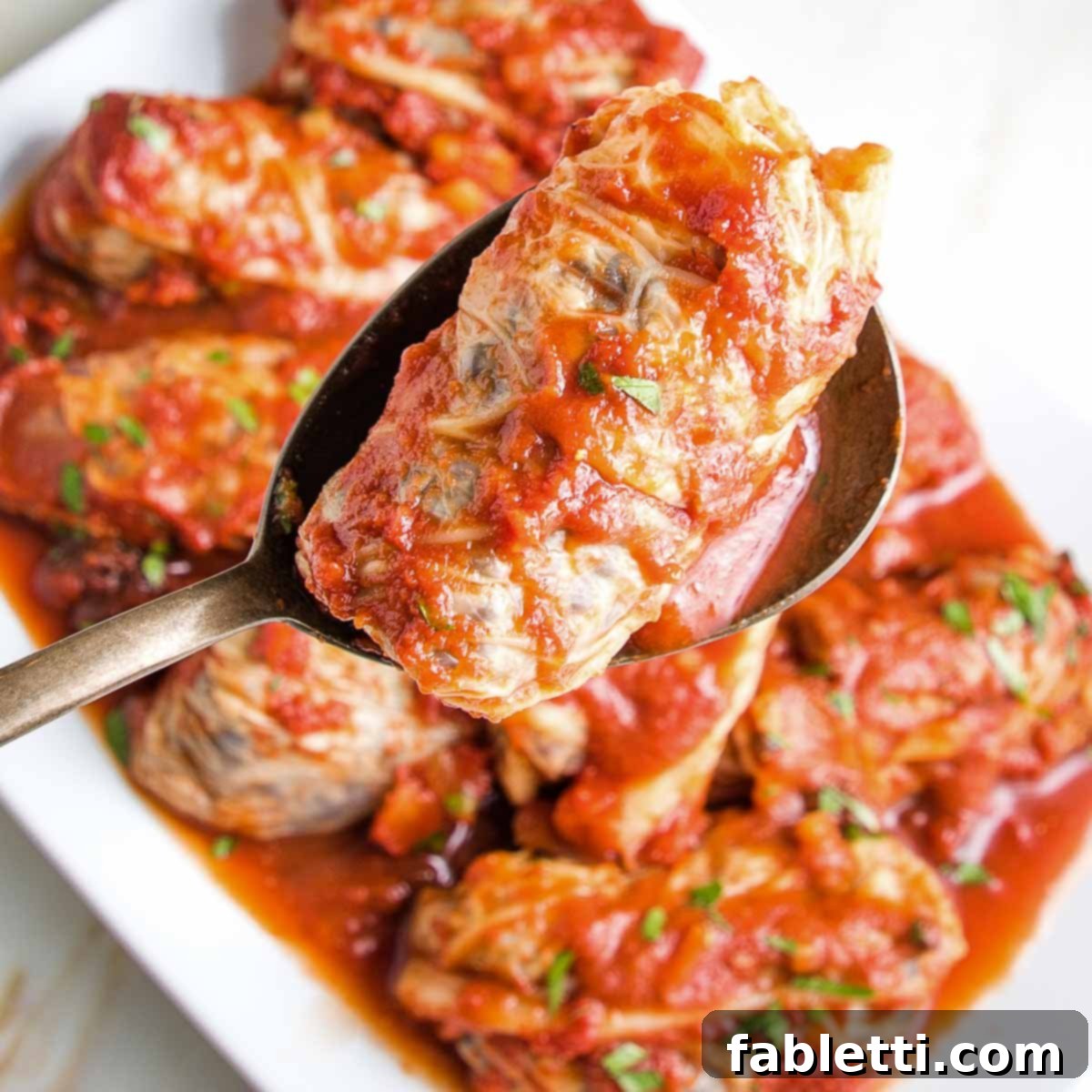Welcome to the ultimate guide for crafting the most satisfying and wholesome **Vegan Stuffed Cabbage Rolls**. This beloved dish, reimagined for the modern plant-based kitchen, offers a delightful blend of hearty textures and a tantalizing sweet and sour flavor profile. Forget the traditional meat-laden versions; our recipe uses a rich, flavorful filling of lentils and cauliflower rice, lovingly wrapped in tender cabbage leaves, and baked to perfection in a homemade sauce. It’s a healthy comfort food that will impress even the most discerning palates, reminiscent of cherished family recipes but without the saturated fats.
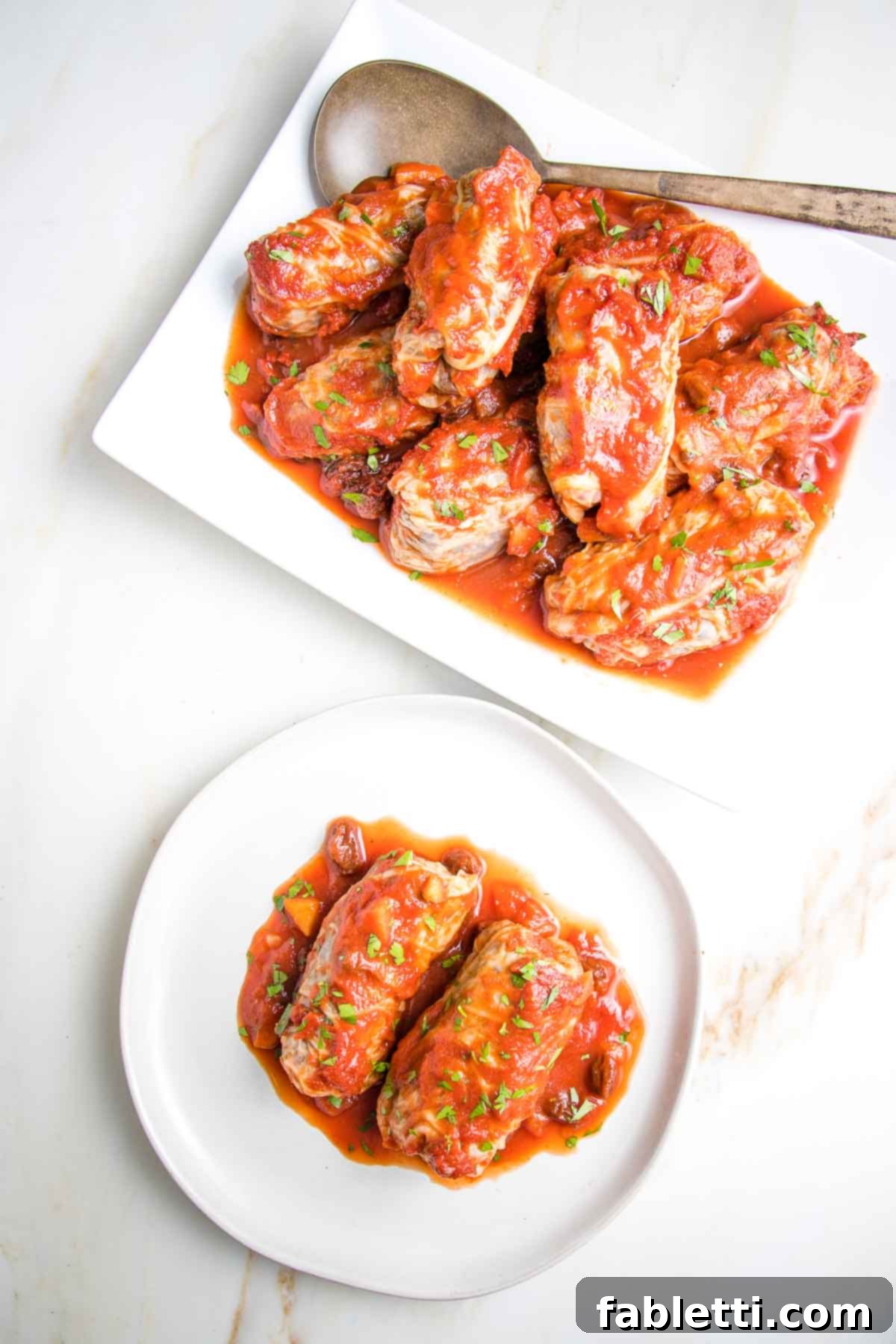
For many, stuffed cabbage evokes warm memories of grandmother’s kitchen, a dish made with love and time. While I always adored my grandmother’s recipe, I long believed creating a vegan version would be overly complicated and perhaps not worth the effort. How wrong I was! These **plant-based cabbage rolls** are not only incredibly delicious but surprisingly straightforward to prepare. They are wonderfully filling and satisfying, yet leave you feeling energized rather than sluggish. This recipe is an absolute must-try for anyone seeking a deeply flavorful and nourishing meal. You’ll want to make them again and again!
My goal was to simplify the process without compromising on flavor or texture. I’ve discovered clever tips and tricks to make this culinary endeavor a breeze. The secret to perfectly tender cabbage leaves? An easy-peasy freezing method that eliminates the fuss of boiling. For the heart of the dish, a robust and super tasty plant-based filling. And of course, the crowning glory: a mouthwatering tangy sweet and sour sauce made from everyday pantry ingredients. While the aromatic magic unfolds in your oven, you can simply sit back, relax, and anticipate the incredible meal awaiting you. Who’s ready to dive in?
Why These Vegan Stuffed Cabbage Rolls Are a Must-Try
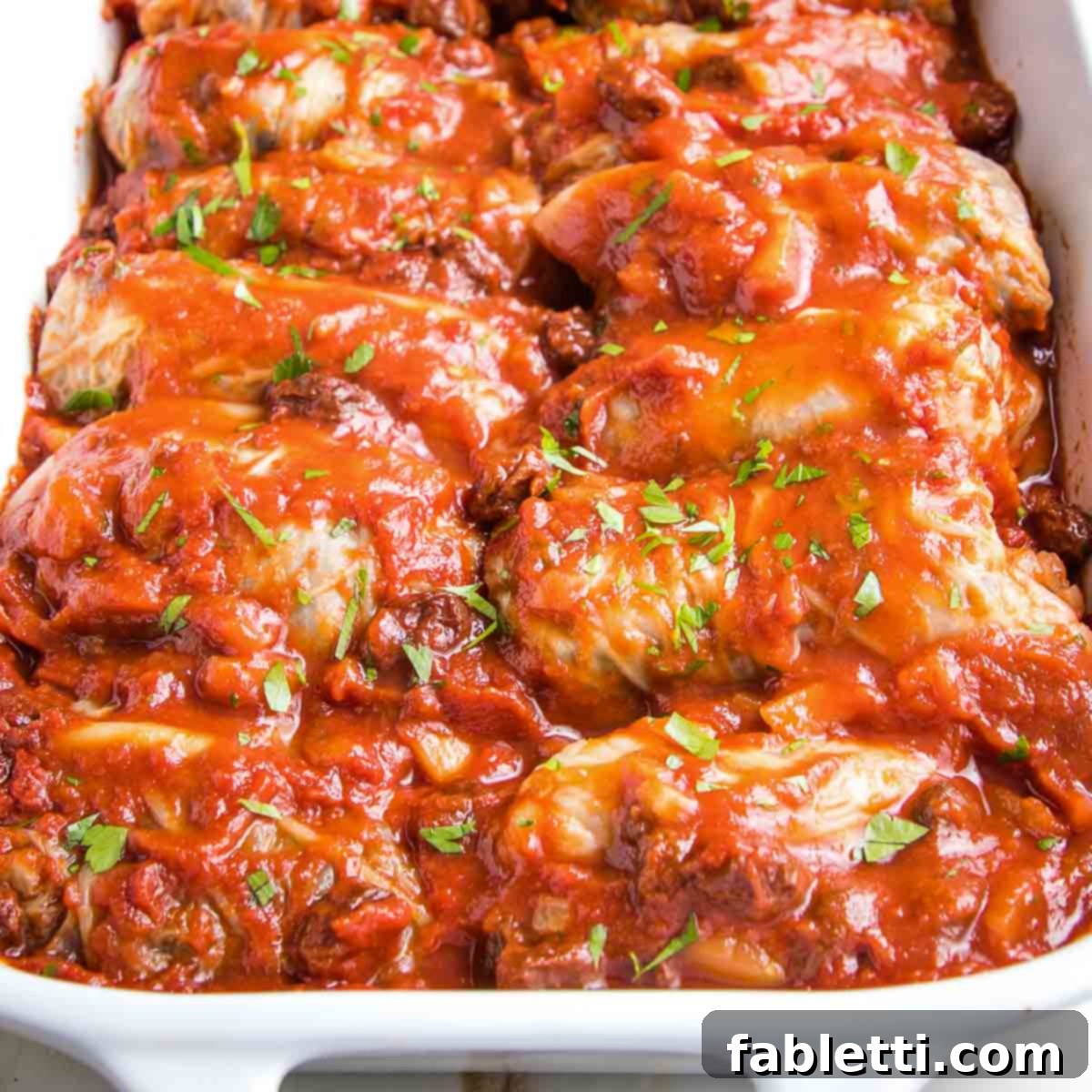
This recipe for **vegan stuffed cabbage** isn’t just another dish; it’s a culinary triumph that brings together tradition and modern, healthy eating. Here’s why these plant-based rolls will become a staple in your kitchen:
- A Wholesome and Hearty Plant-Based Dinner: Packed with nutrient-dense lentils and vegetables, these cabbage rolls offer a complete and satisfying meal that will leave you feeling nourished and content, without any heavy ingredients.
- Excellent for Meal Prep: Prepare a batch on the weekend and enjoy wholesome meals throughout the week. These rolls reheat beautifully, making them perfect for busy weeknights or packed lunches.
- Irresistible Sweet and Sour Sauce: Crafted from simple pantry staples, this sauce delivers an explosion of tangy, sweet, and savory flavors that perfectly complements the hearty filling. Its depth of flavor elevates the entire dish.
- Elegant Yet Effortless: Despite their impressive appearance, these stuffed cabbage rolls are surprisingly easy to make. They look sophisticated enough for a special occasion, yet the process is manageable for any home cook.
- Ideal for Holidays and Special Gatherings: Looking for a standout dish for Thanksgiving, Christmas, or any festive occasion? These vegan cabbage rolls are sure to be a crowd-pleaser and a conversation starter, especially for guests seeking plant-based options.
- The Epitome of Healthy Comfort Food: This recipe delivers all the warmth and nostalgia of classic comfort food, but with a nutritious twist. It’s a meal you can feel good about eating and serving to your loved ones.
Beyond their delicious taste and healthy profile, these rolls are truly impressive when presented. Your guests will marvel at the effort you “fussed” over, never needing to know just how simple they were to create. They are genuinely holiday-meal worthy, and that’s a secret we can keep between us, right?
Selecting the Best Cabbage for Rolling
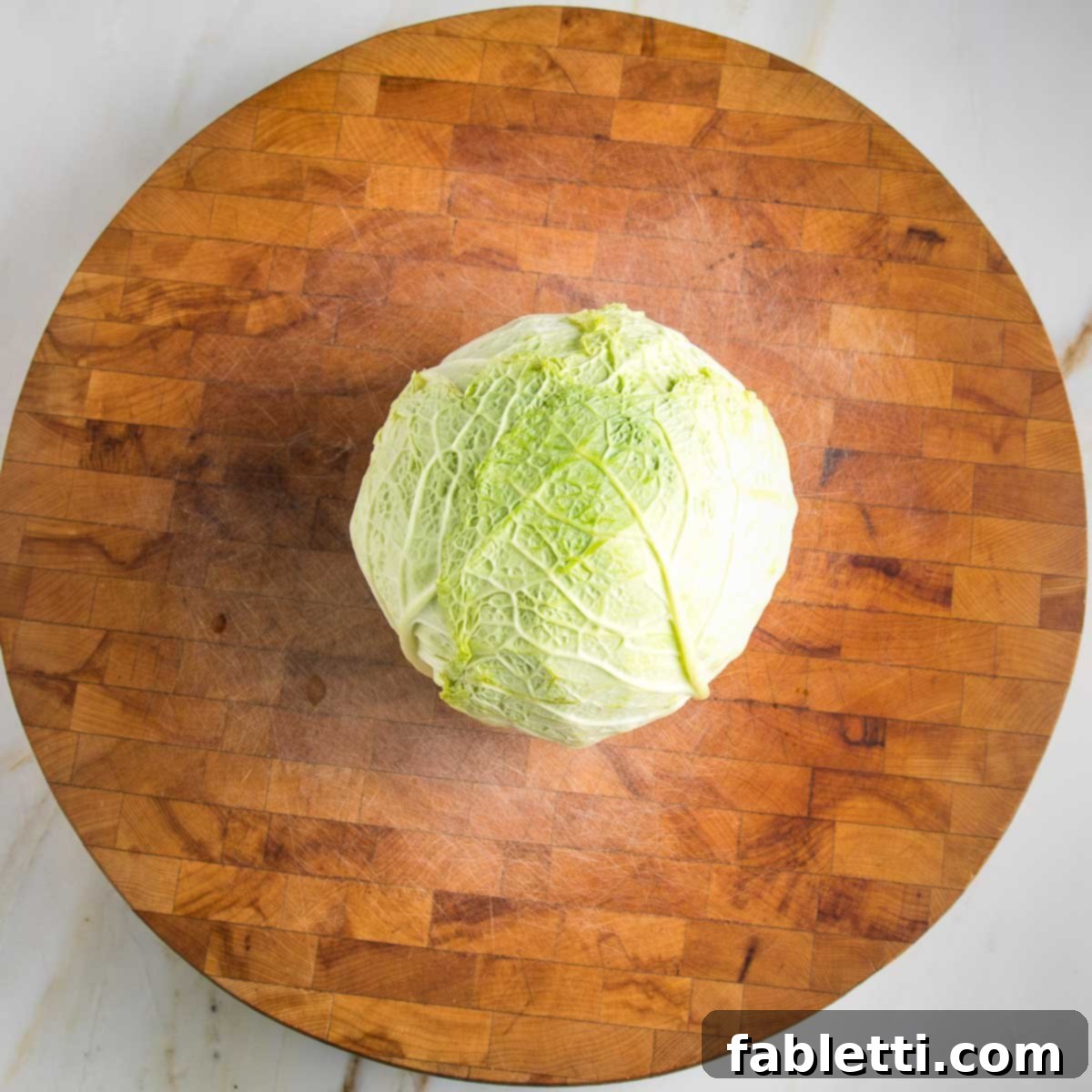
The type of cabbage you choose plays a significant role in the success of your stuffed cabbage rolls. Traditionally, green cabbage is the go-to variety for its large, sturdy leaves, which are excellent for wrapping. While red cabbage can also be used, be aware that its beautiful purple hue tends to deepen into a darker, almost inky color during cooking, which might alter the visual appeal of your dish.
However, my personal favorite and highly recommended choice for cabbage rolls is **Savoy cabbage**. Savoy stands out due to its distinctive crinkled, tender leaves. This unique texture not only makes the leaves incredibly pliable and easy to roll, but it also contributes a beautiful aesthetic to the finished dish. In my experience, Savoy cabbage softens and becomes tender much faster than regular green cabbage, requiring less cooking time and yielding a more delicate texture. Its variegated leaves add an extra touch of elegance, making your stuffed cabbage rolls even more appealing.
How to Achieve Perfectly Soft Cabbage Leaves
Softening the cabbage leaves is perhaps the most crucial step in making stuffed cabbage rolls. Properly softened leaves are pliable, easy to roll, and contribute to the overall tender texture of the baked dish. Here are two effective methods to prepare your cabbage:
The Convenient Freezer Method
This method is a game-changer for those who prefer a hands-off approach and want to avoid the hot water of the boiling method. Freezing naturally breaks down the cellular structure of the cabbage leaves, making them incredibly flexible and easy to handle once thawed. It’s also much safer than maneuvering a large head of cabbage in boiling water.
- Why choose the freezer method? If the thought of wrestling a large head of cabbage in and out of boiling water seems daunting, this method is significantly easier and safer. Freezing effectively tenderizes the leaves, making them pliable and ideal for rolling. As the cabbage defrosts, it naturally wilts, releasing excess water and becoming perfectly soft.
- Preparing cabbage for freezing: Begin by removing any tough or damaged outer leaves from the cabbage head. Give the cabbage a good rinse under cold water, then pat it thoroughly dry. This drying step is important to prevent excessive ice formation. At this stage, you do not need to core the cabbage; it will be much simpler to do so once the cabbage has softened.
- Freezing the cabbage: Place the entire cleaned and dried head of cabbage into a large zip-top freezer-safe bag. Before sealing, press out as much air as possible to minimize freezer burn. If you’re preparing multiple heads of cabbage, freeze each one in a separate bag to ensure even freezing and thawing.
- How long to freeze? For best results, freeze the cabbage for 1 to 2 days. It can also be frozen for as long as 2 weeks, offering great flexibility for advanced meal preparation.
- Thawing the cabbage: When you’re ready to make your rolls, transfer the frozen cabbage from the freezer to your refrigerator to thaw overnight, or allow it to thaw at room temperature for a few hours. Place the head of cabbage on a kitchen towel or in a shallow dish, as it will release a considerable amount of water as it thaws and wilts. Once soft, carefully cut out the core and gently peel off the leaves. Trim any overly thick stems at the base of each leaf with kitchen shears or a sharp knife to ensure smooth rolling.
The Traditional Boiling Method
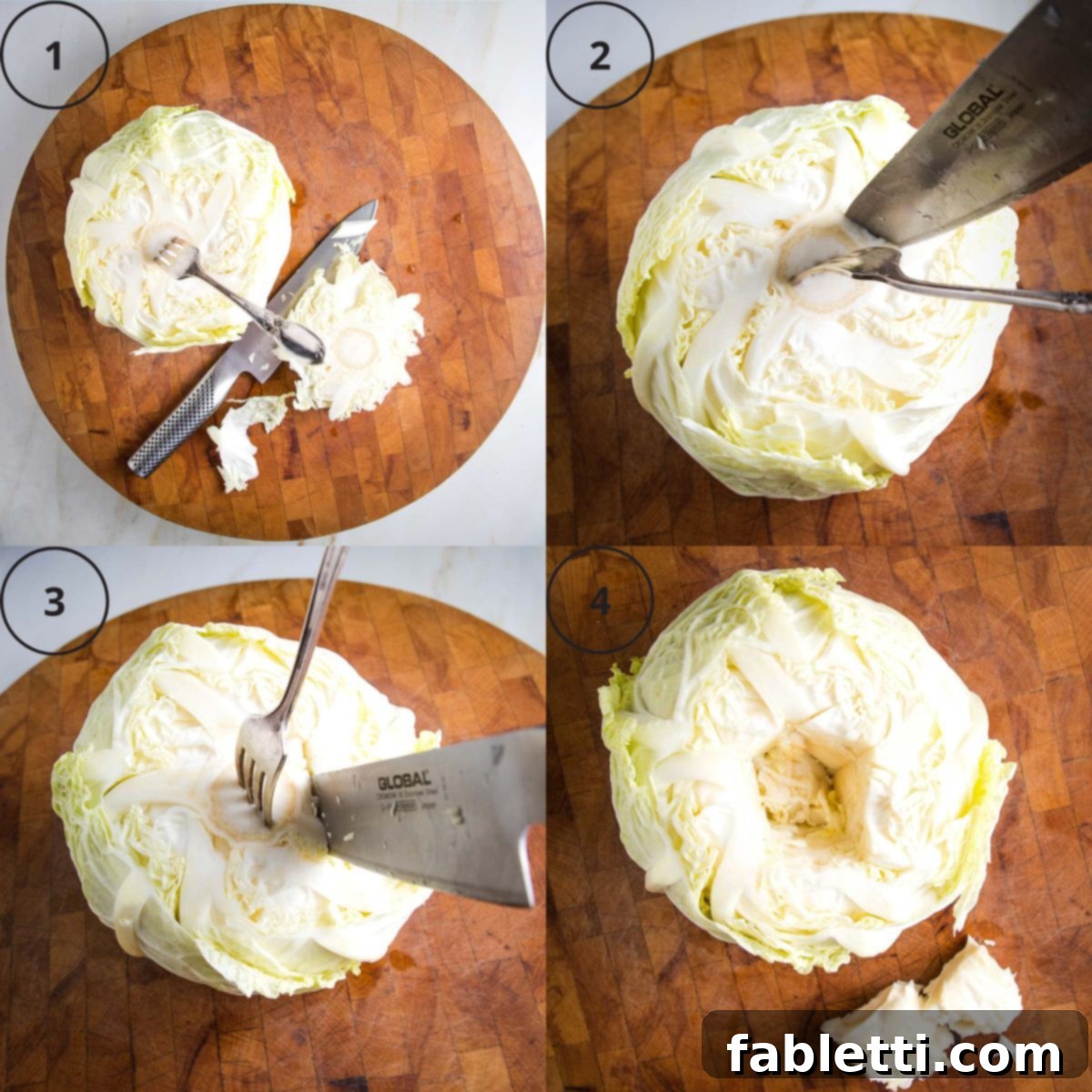
If you need your cabbage softened quickly or prefer the traditional approach, the boiling method is equally effective. It requires a bit more hands-on attention but delivers tender leaves swiftly.
- Before boiling, use a sharp chef’s knife and/or a small paring knife to carefully remove the core of the cabbage. This makes it easier to peel off the leaves later.
- Bring a large pot of salted water to a rolling boil. Ensure the pot is large enough to submerge the entire cabbage head.
- Using a large pair of tongs, carefully place the whole cored head into the boiling water, core side down.
- Allow the water to return to a boil, then reduce the heat to a low simmer.
- Cook the cabbage until the outer leaves become tender and can be easily peeled off. This typically takes 8-10 minutes, depending on the size and density of your cabbage. The leaves should be soft enough to roll without tearing.
- Once tender, remove the cabbage from the water using tongs and place it on a clean dish towel to drain. As the outer leaves cool, gently peel them away. If the inner leaves are still firm, return the cabbage to the simmering water for a few more minutes until tender, then repeat the peeling process. Trim any thick stems on the leaves.
Crafting the Irresistible Sweet & Sour Sauce

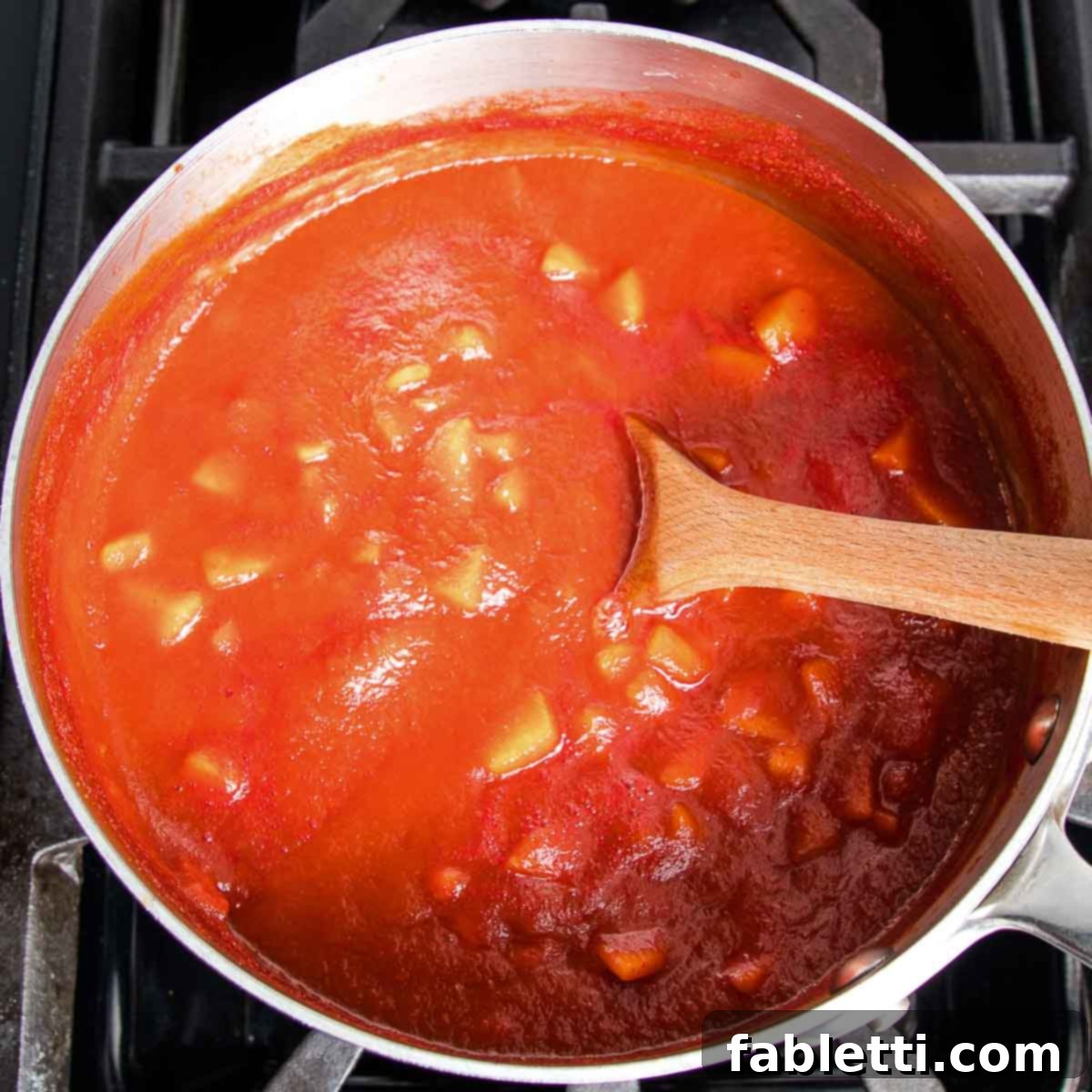
The sweet and sour sauce is the heart and soul of these **vegan stuffed cabbage rolls**, providing that signature tangy sweetness that makes the dish truly unforgettable. This homemade version is simple to prepare and uses readily available ingredients.
- Tomato Sauce: Opt for high-quality organic tomato sauce, ideally in a glass jar, with a minimal ingredient list – preferably just tomatoes. This ensures a pure, rich tomato base for your sauce.
- Pineapple Juice: This secret ingredient adds a natural sweetness and a subtle tropical tang that beautifully balances the savory elements. I always keep a bottle in my fridge; it’s fantastic for creating other sweet and sour vegan dishes, like vegan sweet and sour meatballs.
- Raisins: Beyond their sweet flavor, raisins provide a lovely textural contrast and act as a natural sweetener, contributing to the “sweet” in sweet and sour. They’re also handy to have around for treats like easy oatmeal raisin cookies.
- Apples: The chunks of apple become incredibly tender and flavorful as they cook in the sauce, adding a delightful depth. For a more subtle apple flavor and smoother texture, you can grate the apples instead of dicing them.
- Red Wine Vinegar: This ingredient is essential for the “sour” component, providing a sharp, bright acidity that cuts through the sweetness. Excellent substitutes include fresh lemon juice, apple cider vinegar, unseasoned rice vinegar, or white wine vinegar if red wine vinegar is unavailable.
Combine these ingredients in a saucepan and let them simmer gently, allowing the flavors to meld into a rich, complex sauce that will coat your cabbage rolls beautifully.
Crafting the Hearty Plant-Based Filling

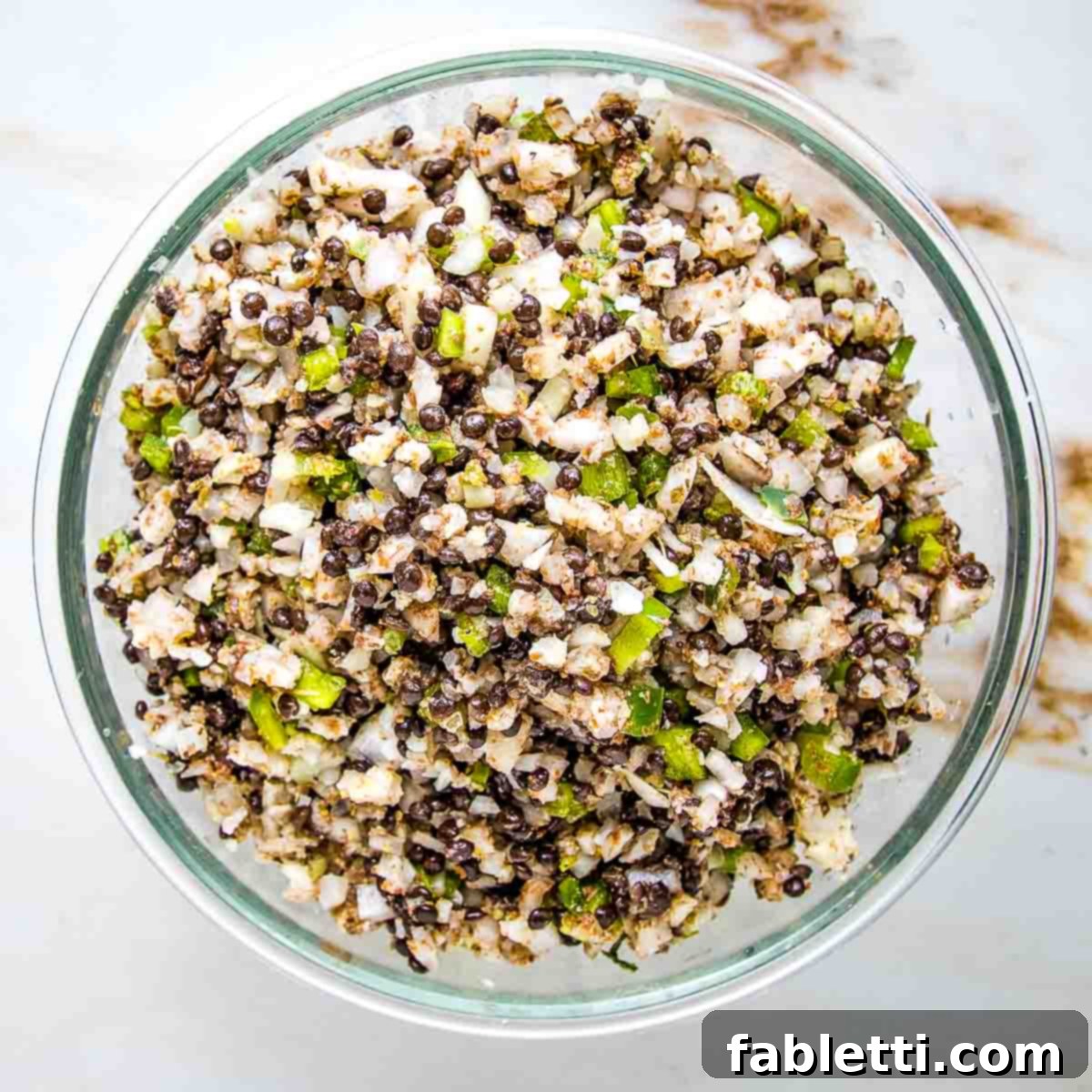
The filling is where these **vegan stuffed cabbage rolls** truly shine, offering incredible texture and flavor. This plant-based mixture is designed to be both nutritious and satisfying, making it a stellar alternative to traditional meat fillings. The best part? There’s no need to pre-cook the filling, as it will steam and become wonderfully tender and flavorful as the cabbage rolls bake in the oven.
- Legumes for Protein and Fiber: I highly recommend using cooked lentils for a robust source of plant-based protein and essential fiber. Brown or green lentils work best as they hold their shape and texture well. Red or yellow lentils are generally too soft for this application. If you prefer, cannellini or pinto beans are also excellent choices; their soft texture allows them to be easily mashed and incorporated into the rest of the ingredients, adding a creamy element.
- Flavorful Vegetable Base: The filling comes alive with the addition of finely chopped onions and green peppers. These vegetables not only provide vibrant flavors and aromas but also add texture to each bite. Freshly pressed garlic infuses the mixture with a pungent warmth, while a blend of dried Italian spices adds an herbaceous depth.
- Cauliflower Rice for Texture and Nutrition: One cup of cauliflower rice is incorporated to add bulk, texture, and an extra boost of vegetables. It mimics the light, grainy texture often found in traditional fillings without adding extra carbs. For convenience, frozen cauliflower rice works perfectly.
- Ground Flax Seeds as a Binder: Ground flax seeds act as a natural binder, helping to hold the filling together during rolling and baking. When combined with the moisture from the other ingredients, they form a gel-like consistency, ensuring your rolls stay intact.
- Simple Mixing, Maximum Flavor: The beauty of this filling is its simplicity. It takes just a few minutes to combine the cooked lentils (or mashed beans), chopped onions, green peppers, cauliflower rice, ground flax, garlic, and spices in a bowl. Mix everything thoroughly to ensure all ingredients are evenly distributed. This uncooked mixture will transform into a rich, aromatic filling as it slowly bakes within the cabbage leaves.
Effortless Stuffing and Folding for Perfect Rolls
Once your cabbage leaves are tender and your filling is ready, it’s time for the art of rolling. This step is surprisingly easy, and with a little practice, you’ll be creating beautiful, perfectly wrapped **vegan stuffed cabbage rolls** in no time. The goal is a snug roll that keeps the filling intact during baking.

Lay a softened cabbage leaf flat on a clean surface, such as a cutting board. Place a generous spoonful (about 1-2 tablespoons, depending on leaf size) of the plant-based filling near the stem end, slightly off-center.
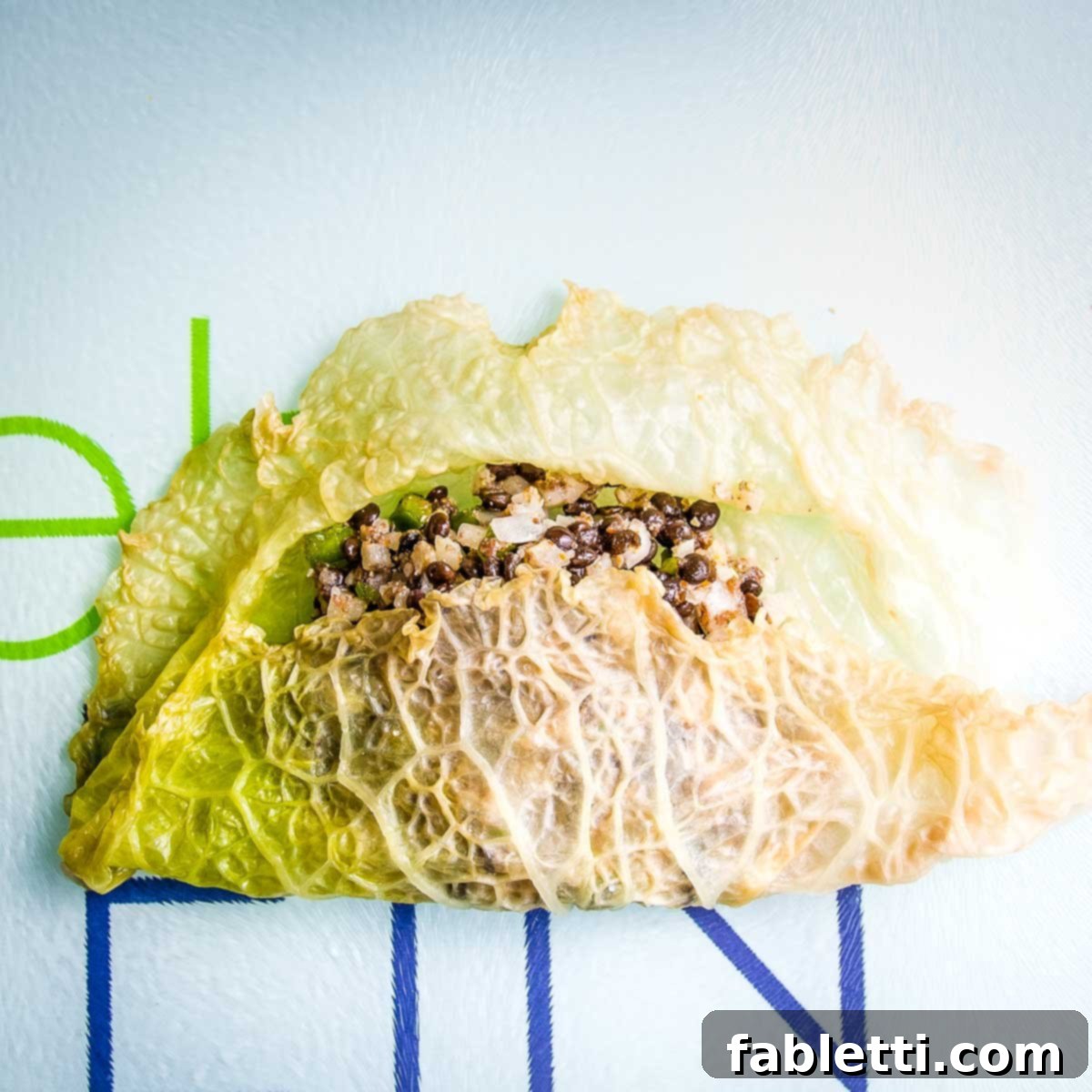
Take the bottom edge of the cabbage leaf and fold it up towards the center, securely covering the filling. This creates the initial base of your roll.
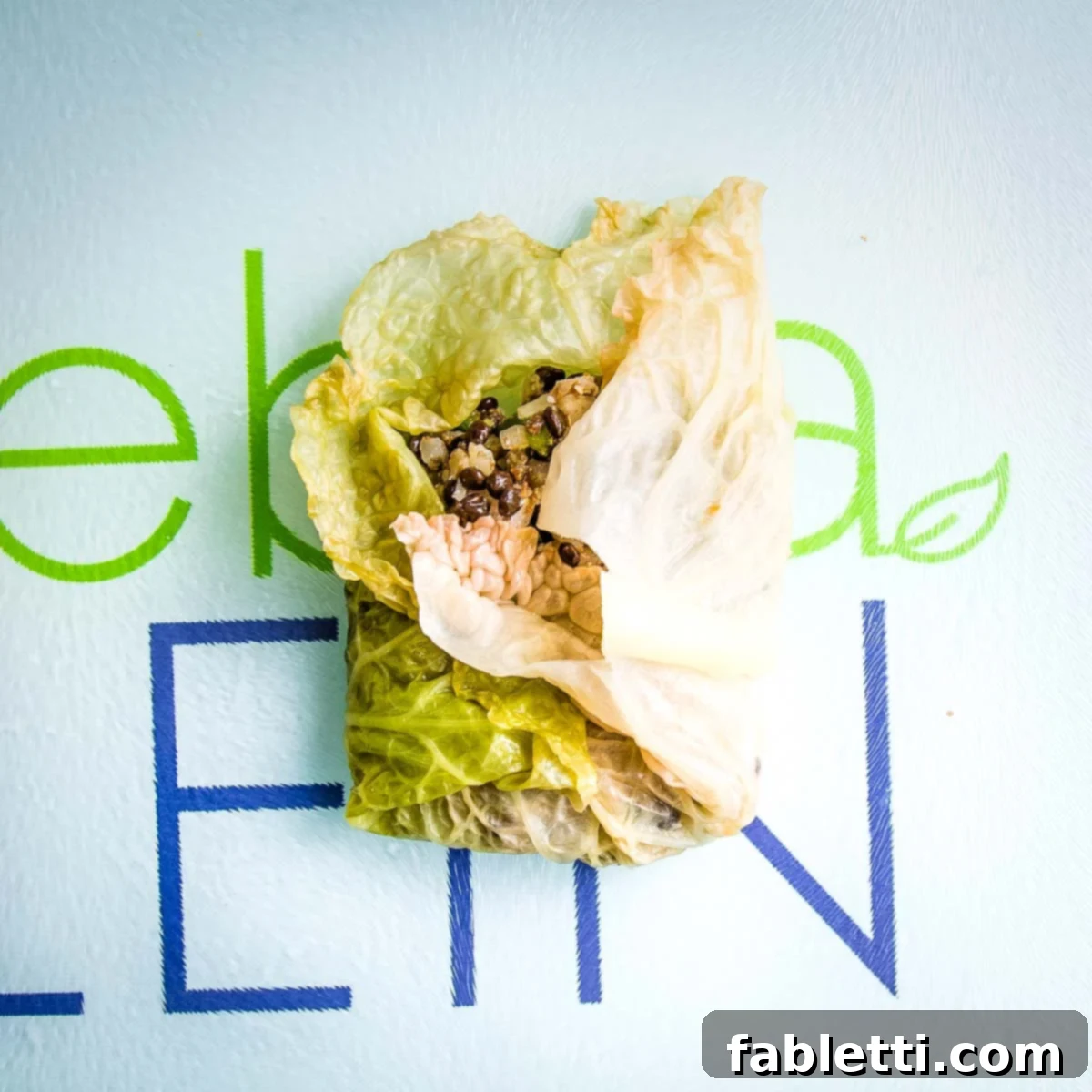
Now, fold both the left and right sides of the cabbage leaf inward towards the center. This action creates neat, sealed ends, preventing the filling from escaping.

Finally, starting from the folded bottom, tightly roll the cabbage leaf upwards, away from you, forming a compact log. Place the finished cabbage roll seam side down to keep it secure.
Preparing Vegan Cabbage Rolls for Baking
Once your **vegan stuffed cabbage rolls** are meticulously crafted, the next step is to arrange them in a baking dish, ready for their transformation in the oven. Proper layering ensures even cooking and allows the rolls to absorb all the wonderful flavors of the sweet and sour sauce.
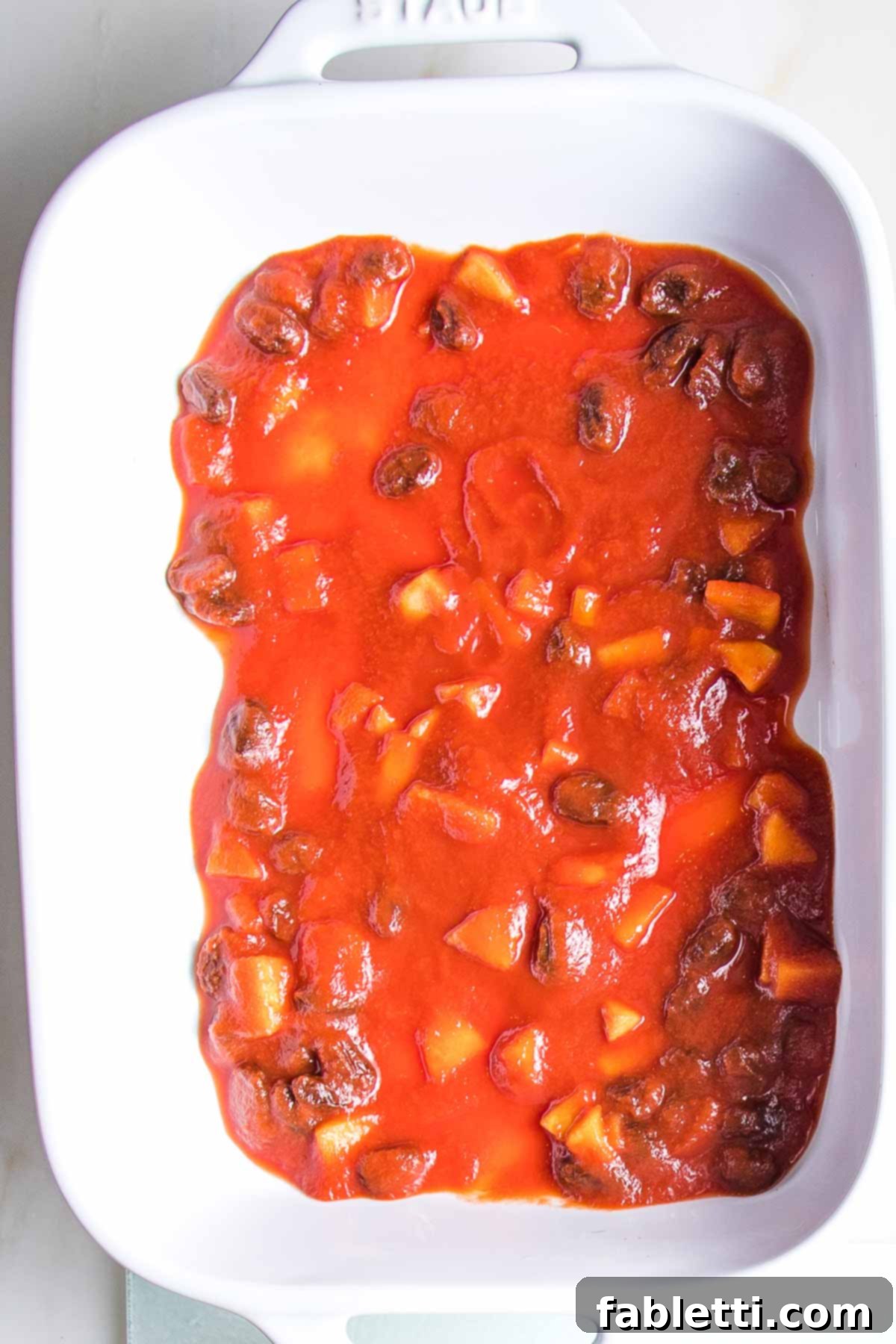
Start by spreading a generous amount of your prepared sweet and sour sauce (about ¾ cup) onto the bottom of a deep baking dish. This foundational layer will infuse the bottom of the rolls with flavor and prevent them from sticking.

Now, carefully place each rolled cabbage leaf, seam side down, onto the sauce in the dish. Arrange them snugly next to each other in a single layer, or in multiple layers if your dish is deep enough and you have many rolls.

Continue to roll and arrange the cabbage rolls until your baking dish is full. Once all the rolls are in place, spoon the remaining sweet and sour sauce evenly over them, ensuring they are well-coated.
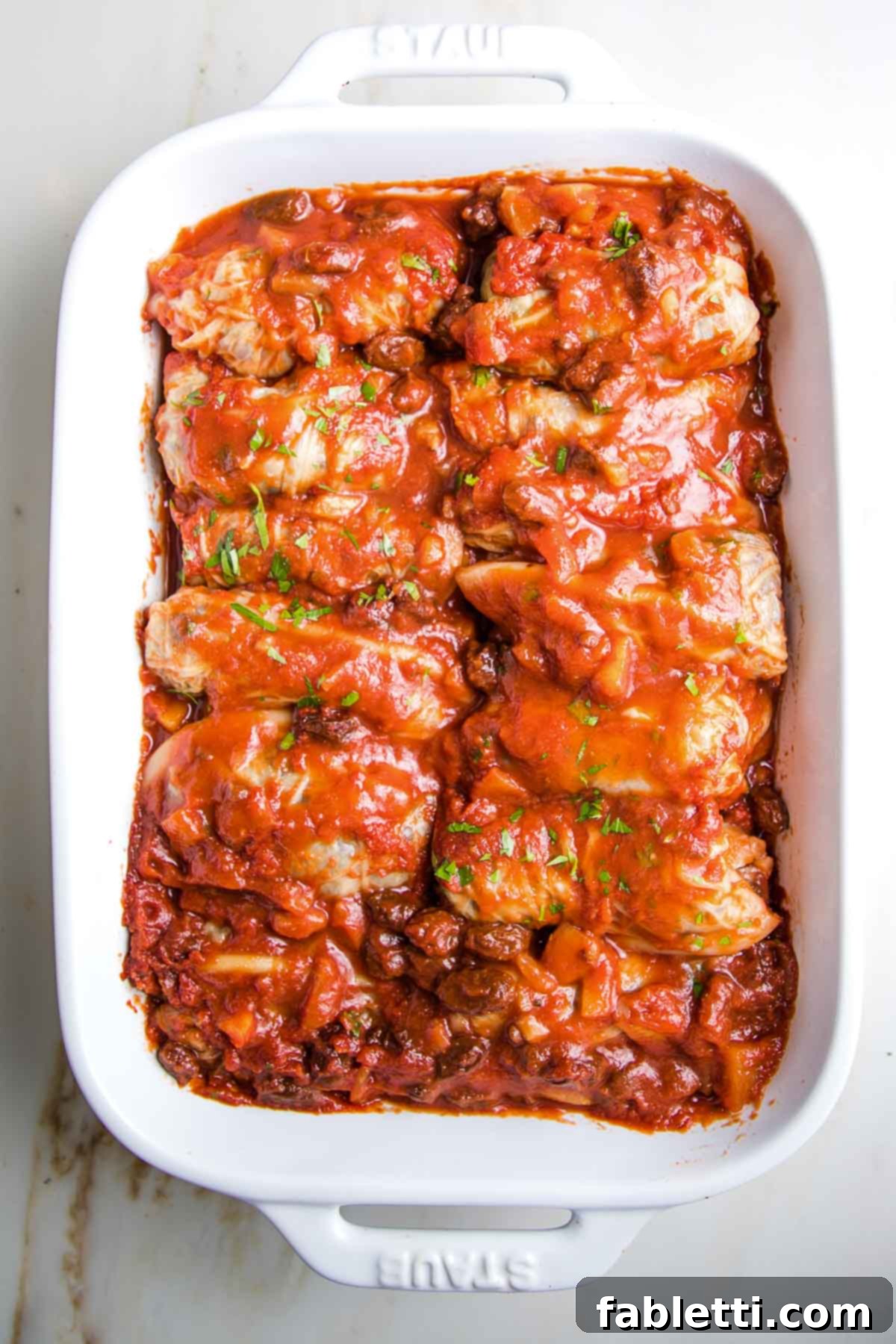
Pour about ¾ cup of water over the entire dish; this will help create a steaming environment in the oven, ensuring the cabbage and filling become incredibly tender. Cover the baking dish tightly with a lid or aluminum foil and bake in a preheated 350-degree Fahrenheit (175°C) oven for approximately 90 minutes, or until the cabbage is soft and the filling is cooked through.
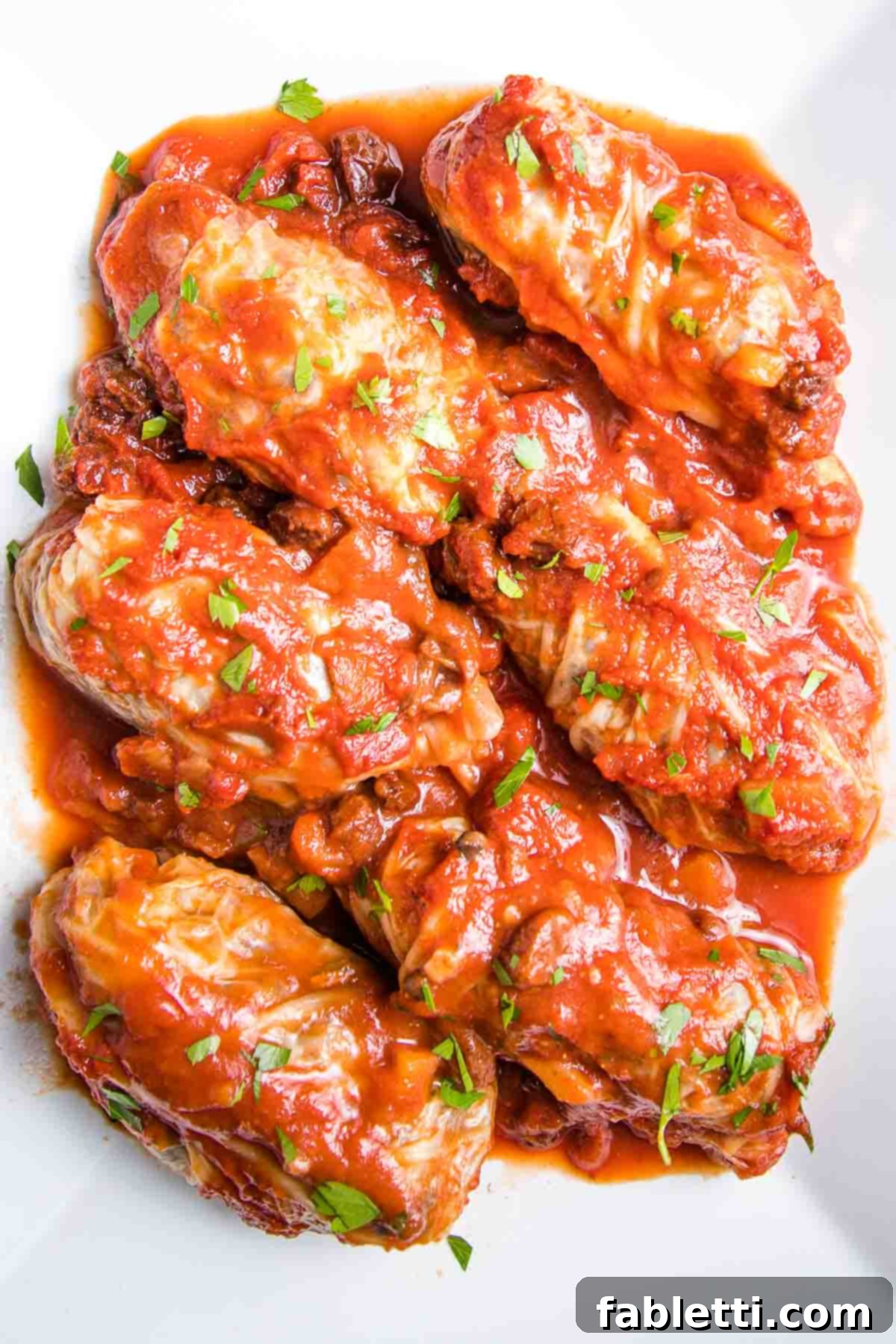
Expert Tips for Vegan Stuffed Cabbage Success

Making **vegan stuffed cabbage rolls** is a rewarding experience, and these expert tips will help ensure your dish turns out perfectly every time:
- Embrace Passive Time: Don’t be deterred by the total preparation and cooking time for this recipe. A significant portion of it is passive baking time, during which your oven does all the hard work. You’ll have plenty of time to relax or tackle other tasks while your delicious meal simmers to perfection.
- Double Batch for Future Meals: A single large head of cabbage often yields enough leaves to create a double batch of rolls. Consider making extra: one batch to enjoy immediately and another to freeze for a quick and convenient meal on another day. Your future self will thank you!
- Speedy Prep Shortcuts: In a rush? You can significantly cut down on prep time without sacrificing flavor. Opt for canned lentils or beans (rinsed and drained) instead of cooking them from scratch, and use pre-packaged frozen cauliflower rice. Simply mix these pre-prepared ingredients with your aromatics and spices, and you’re ready to fill your cabbage leaves.
- Customizing the Filling: Feel free to experiment with the filling. Add other finely diced vegetables like carrots, mushrooms, or spinach. You can also boost the flavor with a touch of smoked paprika or a pinch of red pepper flakes for a subtle kick.
- Perfecting the Roll: If a cabbage leaf tears slightly while rolling, don’t worry! You can often patch it up with a smaller piece of cabbage leaf or simply ensure that the torn section is covered by the surrounding rolls in the baking dish. The sauce will help everything meld together.
- Sauce Adjustments: Taste your sweet and sour sauce before adding it to the rolls. If you prefer it sweeter, add a touch more pineapple juice or a spoonful of maple syrup. For more tang, a splash more red wine vinegar will do the trick.
Meal Prep and Storage Solutions
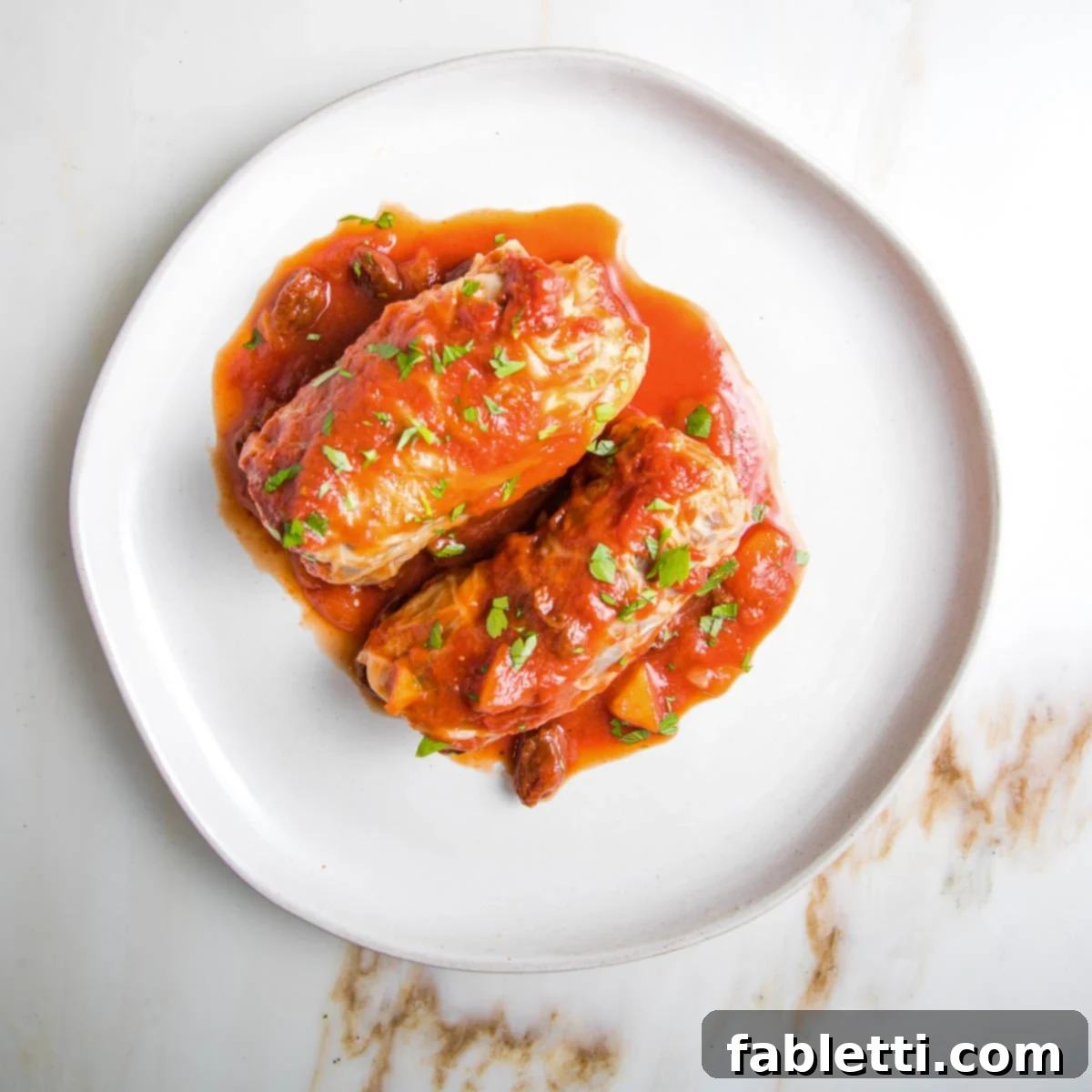
One of the many advantages of these **vegan stuffed cabbage rolls** is their incredible meal prep versatility. You can prepare various components in advance, making assembly quick and easy, and they store wonderfully for future meals.
- Prep Ahead:
- Filling: The plant-based filling can be mixed up to a week in advance. Store it in an airtight container in the refrigerator, ready for when you are.
- Sauce: The sweet and sour sauce also holds up beautifully when made ahead. Prepare it and keep it in a sealed container in the fridge for up to a week.
- Cabbage: Utilize the freezer method for softening your cabbage leaves up to a week in advance. Simply defrost the cabbage overnight in the refrigerator before you plan to roll them. This makes the rolling process incredibly efficient.
- Storage of Cooked Rolls: Once baked, the entire casserole of stuffed cabbage rolls can be stored, tightly covered, in the refrigerator for up to 5 days. This makes them perfect for nourishing lunches and dinners throughout the week.
- Freezing for Longer Storage: Stuffed cabbage rolls freeze exceptionally well, offering a convenient make-ahead option.
- Method 1 (Casserole style): Allow the baked casserole to cool completely. Then, cover it tightly with foil and freeze for up to 3 months. For best results and easy reheating, I often use glass containers with airtight lids for freezing casseroles.
- Method 2 (Individual rolls): For individual portions, allow rolls to cool, then arrange them in a single layer on a baking sheet and flash freeze until solid. Transfer to a freezer-safe bag or container with parchment paper between layers.
- Defrosting: Always defrost frozen cabbage rolls overnight in the refrigerator before reheating.
- Reheating: To reheat, place the defrosted stuffed cabbage rolls (covered) in a preheated 350-degree Fahrenheit (175°C) oven for about 30 minutes, or until heated through and bubbling. If reheating from frozen (not recommended for best texture, but possible), it will take longer. You can also gently reheat individual portions in the microwave.
Your feedback means the world to food bloggers! If you’ve tried this delicious **Vegan Stuffed Cabbage** recipe, please consider leaving a five-star rating and a comment below to share your experience. We love seeing your culinary creations! Don’t forget to share your photos on Instagram by tagging @dkhealthcoach and using the hashtag #debraklein. Happy cooking!
📖 Recipe

Vegan Stuffed Cabbage Rolls
Debra Klein
Rate this Recipe
Pin Recipe
20 minutes
1 hour 30 minutes
2 days
2 days 1 hour 50 minutes
Main Course
American
6 servings
231 kcal
Equipment
- 3 quart baking dish
- Glass Mixing Bowls with Lids
- Sauce Pan with Lid
Ingredients
-
1 head cabbage green or savoy
Sweet and sour sauce
-
2 15-oz cans tomato sauce -
½ cup raisins -
2 small apples peeled and diced small or shredded -
¼ cup red wine vinegar* -
½ cup pineapple juice
Filling
-
1 ½ cups cooked lentils* -
1 medium onion grated or finely diced -
1 small green pepper small dice -
1 cup cauliflower rice -
¼ cup ground flax seeds -
3 cloves garlic pressed -
1 Tablespoon dried Italian spices -
½ teaspoon coarse sea salt
Instructions
- PREPARE (SOFTEN) CABBAGE: Pull off any tough outer leaves from the cabbage. Rinse the cabbage head and pat it dry.
Freezer Method: Place the cleaned cabbage head in a zip-top freezer-safe bag and freeze for 2-3 days (or up to 2 weeks). Defrost the cabbage at room temperature for a few hours, or overnight in the refrigerator. The cabbage will naturally wilt and release water as it defrosts (I recommend placing it on a dish towel to catch the moisture). Carefully cut off the stem and remove the leaves gently. If necessary, trim any thick stems with kitchen shears or a sharp knife to make them easier to roll.
Boiling Method (Alternative): If you didn’t plan ahead for freezing, you can boil the cabbage to soften it. Use a large pot (4-quart or larger), filled at least halfway with water (enough to fully submerge the cabbage). Bring water to a boil, then reduce to a low simmer. Place the cored cabbage head into the simmering water for about 15 minutes, or until leaves are tender. Remove and carefully peel off leaves one by one, trimming thick stems as needed. - Cook lentils according to package directions. This recipe calls for already cooked lentils, which can be prepared up to 3 days in advance and stored in the fridge.
- MAKE THE FILLING: In a large bowl, combine the cooked lentils, grated or finely diced onions, small-diced green peppers, cauliflower rice, ground flax seeds, pressed garlic, and dried Italian spices. Mix all ingredients thoroughly until well combined. If using canned beans as an alternative to lentils, mash them slightly with a fork before blending with the other ingredients.
- MAKE THE SAUCE: In a saucepan, combine the tomato sauce, raisins, diced or shredded apples, red wine vinegar, and pineapple juice. Bring to a gentle simmer over low heat and cook for 15 minutes, allowing the flavors to meld.
- Preheat your oven to 350°F (175°C).
- Spread approximately ¾ cup of the sweet and sour sauce evenly over the bottom of a deep casserole dish (a 3-quart dish works well).
- Gently pull the softened cabbage leaves off the head. Lay one leaf flat on a clean surface. Place 1-2 tablespoons of the plant-based filling (depending on the size of the leaf) near the stem end. Fold the bottom edge of the cabbage leaf up and over the filling, then fold in both sides towards the center. Finally, roll the entire leaf tightly upwards to form a compact log. Place the rolled cabbage leaf, seam side down, onto the layer of sauce in the casserole dish.
- Continue rolling the remaining leaves and arranging them snugly in the casserole dish until it’s full. Once all rolls are placed, sprinkle with a little salt and pepper, then pour the remaining sweet and sour sauce evenly over the top. Pour ¾ cup of water over the entire dish, then cover it tightly with a lid or aluminum foil. Bake for 90 minutes in the preheated oven, or until the cabbage is soft and the filling is thoroughly cooked and tender.
Notes
ALTERNATE METHOD TO SOFTEN CABBAGE LEAVES (Boiling Method): If you haven’t planned ahead to freeze and defrost the cabbage, the boiling method is a quick way to soften the leaves. Use a 4-quart pot or larger, filling it at least halfway with water (ensure enough water to fully cover the cabbage when submerged). Bring the water to a rolling boil, then reduce the heat to low. Cook the whole cored cabbage head until the outer leaves soften, typically about 15 minutes. Carefully remove the cabbage from the pot and begin peeling off the softened outer leaves one by one. If inner leaves are still firm, return the cabbage to the hot water until they are also pliable. Remember to trim any thick stems from the leaves before rolling.
STORAGE: Baked stuffed cabbage rolls will stay fresh and delicious in an airtight container in the fridge for up to 5 days. For longer storage, you can freeze them for up to 3 months. To freeze, allow the rolls to cool completely, then cover tightly with foil or transfer to freezer-safe containers. Defrost overnight in the fridge before reheating. To reheat, place the defrosted rolls (covered) in a preheated 350-degree F (175°C) oven for 30 minutes, or until heated through.
Nutrition
Serving:
1
g
Calories:
231
kcal
Carbohydrates:
38
g
Protein:
10
g
Fat:
3
g
Polyunsaturated Fat:
2
g
Sodium:
302
mg
Fiber:
12
g
Sugar:
24
g
Note
The nutrition calculations were done using online tools. To obtain the most accurate representation of the nutritional information in any given recipe, you should calculate the nutritional information with the actual ingredients you used. You are ultimately responsible for ensuring that any nutritional information is accurate, complete and useful.
Did you make this recipe?
Please leave a review below, then snap a picture and tag me @dkhealthcoach or use hashtag #dkhealtcoach on Instagram so I can see it!!
